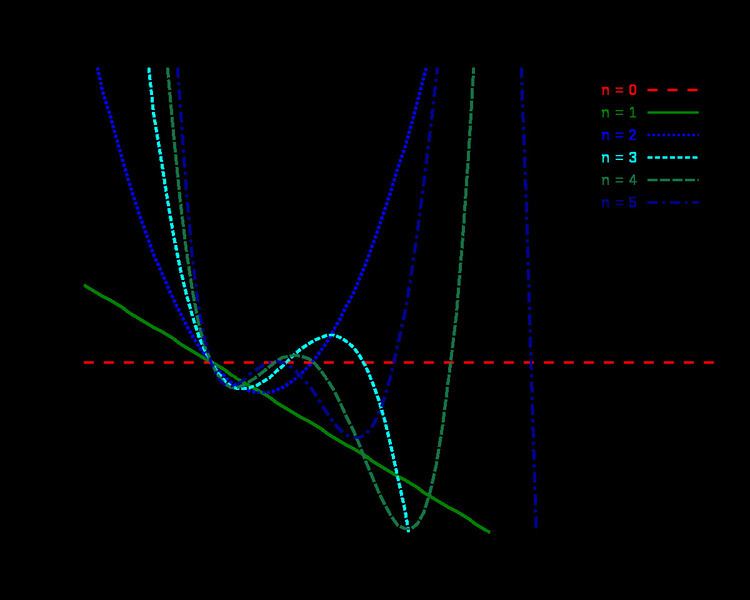 | ||
In mathematics, the Laguerre polynomials, named after Edmond Laguerre (1834 - 1886), are solutions of Laguerre's equation:
Contents
- The first few polynomials
- Recursive definition closed form and generating function
- Generalized Laguerre polynomials
- Explicit examples and properties of the generalized Laguerre polynomials
- As a contour integral
- Recurrence relations
- Derivatives of generalized Laguerre polynomials
- Orthogonality
- Series expansions
- Further examples of expansions
- Multiplication theorems
- Relation to Hermite polynomials
- Relation to hypergeometric functions
- Poisson kernel
- References
which is a second-order linear differential equation. This equation has nonsingular solutions only if n is a non-negative integer.
More generally, the name Laguerre polynomials is used for solutions of
Then they are also named generalized Laguerre polynomials, as will be done here (alternatively associated Laguerre polynomials or, rarely, Sonine polynomials, after their inventor Nikolay Yakovlevich Sonin).
The Laguerre polynomials are also used for Gaussian quadrature to numerically compute integrals of the form
These polynomials, usually denoted L0, L1, ..., are a polynomial sequence which may be defined by the Rodrigues formula,
reducing to the closed form of a following section.
They are orthogonal polynomials with respect to an inner product
The sequence of Laguerre polynomials n! Ln is a Sheffer sequence,
The Rook polynomials in combinatorics are more or less the same as Laguerre polynomials, up to elementary changes of variables. Further see the Tricomi–Carlitz polynomials.
The Laguerre polynomials arise in quantum mechanics, in the radial part of the solution of the Schrödinger equation for a one-electron atom. They also describe the static Wigner functions of oscillator systems in quantum mechanics in phase space. They further enter in the quantum mechanics of the Morse potential and of the 3D isotropic harmonic oscillator.
Physicists sometimes use a definition for the Laguerre polynomials which is larger by a factor of n! than the definition used here. (Likewise, some physicists may use somewhat different definitions of the so-called associated Laguerre polynomials.)
The first few polynomials
These are the first few Laguerre polynomials:
Recursive definition, closed form, and generating function
One can also define the Laguerre polynomials recursively, defining the first two polynomials as
and then using the following recurrence relation for any k ≥ 1:
The closed form is
The generating function for them likewise follows,
Polynomials of negative index can be expressed using the ones with positive index:
Generalized Laguerre polynomials
For arbitrary real α the polynomial solutions of the differential equation
are called generalized Laguerre polynomials, or associated Laguerre polynomials.
One can also define the generalized Laguerre polynomials recursively, defining the first two polynomials as
and then using the following recurrence relation for any k ≥ 1:
The simple Laguerre polynomials are the special case α = 0 of the generalized Laguerre polynomials:
The Rodrigues formula for them is
The generating function for them is
Explicit examples and properties of the generalized Laguerre polynomials
As a contour integral
Given the generating function specified above, the polynomials may be expressed in terms of a contour integral
where the contour circles the origin once in a counterclockwise direction.
Recurrence relations
The addition formula for Laguerre polynomials:
Laguerre's polynomials satisfy the recurrence relations
in particular
and
or
moreover
They can be used to derive the four 3-point-rules
combined they give this additional, useful recurrence relations
Since
The second equality follows by the following identity, valid for integer i and n and immediate from the expression of
For the third equality apply the fourth and fifth identities of this section.
Derivatives of generalized Laguerre polynomials
Differentiating the power series representation of a generalized Laguerre polynomial k times leads to
This points to a special case (α = 0) of the formula above: for integer α = k the generalized polynomial may be written
the shift by k sometimes causing confusion with the usual parenthesis notation for a derivative.
Moreover, the following equation holds:
which generalizes with Cauchy's formula to
The derivative with respect to the second variable α has the form,
This is evident from the contour integral representation below.
The generalized Laguerre polynomials obey the differential equation
which may be compared with the equation obeyed by the kth derivative of the ordinary Laguerre polynomial,
where
In Sturm–Liouville form the differential equation is
which shows that L(α)
n is an eigenvector for the eigenvalue n.
Orthogonality
The generalized Laguerre polynomials are orthogonal over [0, ∞) with respect to the measure with weighting function xα e−x:
which follows from
If
The associated, symmetric kernel polynomial has the representations (Christoffel–Darboux formula)
recursively
Moreover,
Turán's inequalities can be derived here, which is
The following integral is needed in the quantum mechanical treatment of the hydrogen atom,
Series expansions
Let a function have the (formal) series expansion
Then
The series converges in the associated Hilbert space L2[0, ∞) if and only if
Further examples of expansions
Monomials are represented as
while binomials have the parametrization
This leads directly to
for the exponential function. The incomplete gamma function has the representation
Multiplication theorems
Erdélyi gives the following two multiplication theorems
Relation to Hermite polynomials
The generalized Laguerre polynomials are related to the Hermite polynomials:
where the Hn(x) are the Hermite polynomials based on the weighting function exp(−x2), the so-called "physicist's version."
Because of this, the generalized Laguerre polynomials arise in the treatment of the quantum harmonic oscillator.
Relation to hypergeometric functions
The Laguerre polynomials may be defined in terms of hypergeometric functions, specifically the confluent hypergeometric functions, as
where
